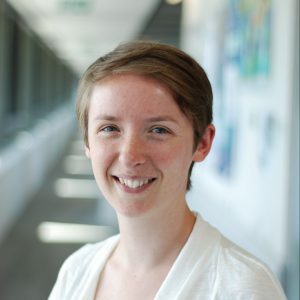
SUE COOK
Research Associate
Glaciologist (modelling)
Co-leader Project 3: Ice shelves
Social Links
Current AAPP Activities:
Sue’s primary research theme is investigating the processes affecting mass loss from Antarctic ice shelves, a major control on future sea level rise. Her work is interdisciplinary, combining numerical modelling of fracture, iceberg calving and ice flow on Antarctic ice shelves with observational work measuring ocean driven melt and changes in ice dynamics around East Antarctica. Specific research themes include:
- Understanding mass loss from glaciers and ice sheets through iceberg calving
- Developing numerical models of fracture processes in glacial ice
- Use of geophysical techniques to track ocean-driven melt of Antarctic ice shelves
Use of GPS to investigate ice sheet dynamics
Current AAPP Activities:
Sue’s primary research theme is investigating the processes affecting mass loss from Antarctic ice shelves, a major control on future sea level rise. Her work is interdisciplinary, combining numerical modelling of fracture, iceberg calving and ice flow on Antarctic ice shelves with observational work measuring ocean driven melt and changes in ice dynamics around East Antarctica. Specific research themes include:
- Understanding mass loss from glaciers and ice sheets through iceberg calving
- Developing numerical models of fracture processes in glacial ice
- Use of geophysical techniques to track ocean-driven melt of Antarctic ice shelves
Use of GPS to investigate ice sheet dynamics
Biography
Dr Sue Cook is a glaciologist and co-project leader for Australian Antarctic Program Partnership Project 3: Ice Shelves. This project aims to identify ocean-driven and cryosphere-driven mass loss from East Antarctic ice shelves, and their susceptibility to changes in climate forcing. Her research involves the study of dynamic processes on ice shelves using a wide range of techniques from numerical modelling to field observation and satellite remote sensing.
Sue joined UTAS in 2015 working as a glaciologist for the Antarctic Climate & Ecosystems CRC. During her time at UTAS she has worked on developing new models of icebergs calving, participated in multiple Antarctic field seasons, and contributed to teaching Antarctic science at UTAS. Prior to arriving in Tasmania she completed her PhD at Swansea University, on the topic of environmental controls on iceberg calving from tidewater glaciers. She then worked for two years as a postdoctoral researcher at the University Centre in Svalbard where she continued her research into iceberg calving processes.
Sue’s primary research theme is investigating the processes affecting mass loss from Antarctic ice shelves, a major control on future sea level rise. Her work is interdisciplinary, combining numerical modelling of fracture, iceberg calving and ice flow on Antarctic ice shelves with observational work measuring ocean driven melt and changes in ice dynamics around East Antarctica. Specific research themes include:
Understanding mass loss from glaciers and ice sheets through iceberg calving
Developing numerical models of fracture processes in glacial ice
Use of geophysical techniques to track ocean-driven melt of Antarctic ice shelves
Use of GPS to investigate ice sheet dynamics
Scientific Committee Memberships
| NERC Discovery Science Grant RIPFISH: Rift propagation in future ice sheet models (Project Partner) |
| Australian Antarctic Science Grant 4342: State Estimate of East Antarctic Ice Shelves (Co-Investigator) |
| Australian Antarctic Program Grant 5145: Helicopter Trials of Ground Penetrating Radar on Glaciers (Chief Investigator) |
| Australian Antarctic Science Grant 4342: Outlet Glacier Dynamics in Princess Elizabeth Land (Co-Investigator) |
Awards / Grants
| NERC Discovery Science Grant RIPFISH: Rift propagation in future ice sheet models (Project Partner) |
| Australian Antarctic Science Grant 4342: State Estimate of East Antarctic Ice Shelves (Co-Investigator) |
| Australian Antarctic Program Grant 5145: Helicopter Trials of Ground Penetrating Radar on Glaciers (Chief Investigator) |
| Australian Antarctic Science Grant 4342: Outlet Glacier Dynamics in Princess Elizabeth Land (Co-Investigator) |
Selected Publications
| Cook, S., Astrom, J., Zwinger, T., Galton-Fenzi, B. K., Greenbaum, J. S., & Coleman, R. (2018). Modelled fracture and calving on the Totten Ice Shelf. The Cryosphere, 12, 2401-2411. |
| Cook, S., Galton-Fenzi, B. K., Ligtenberg, S. R. M., and Coleman, R. (2018). Brief communication: widespread potential for seawater infiltration on Antarctic ice shelves. The Cryosphere, 12, 3853-3859, https://doi.org/10.5194/tc-12-3853-2018. |
| Benn, D. I., Åström, J., Zwinger, T., Todd, J., Nick, F. M., Cook, S., Hulton, R. J. & Luckman, A. (2017). Melt-under-cutting and buoyancy-driven calving from tidewater glaciers: new insights from discrete element and continuum model simulations. Journal of Glaciology, 63(240), 691-702 |
| Cook, S., I.C. Rutt, T. Murray, A. Luckman, T. Zwinger, N. Selmes, A. Goldsack, and T.D. James, (2014). Modelling environmental influences on calving at Helheim Glacier in eastern Greenland. The Cryosphere, 8, 827-841, doi:10.5194/tc-8-827-2014. |
| Cook, S., T. Zwinger, I.C. Rutt, S. O’Neel and T. Murray (2012). Testing the effect of water in crevasses on a physically-based calving model. Annals of Glaciology, 53(60), 90-96. |
Associated links
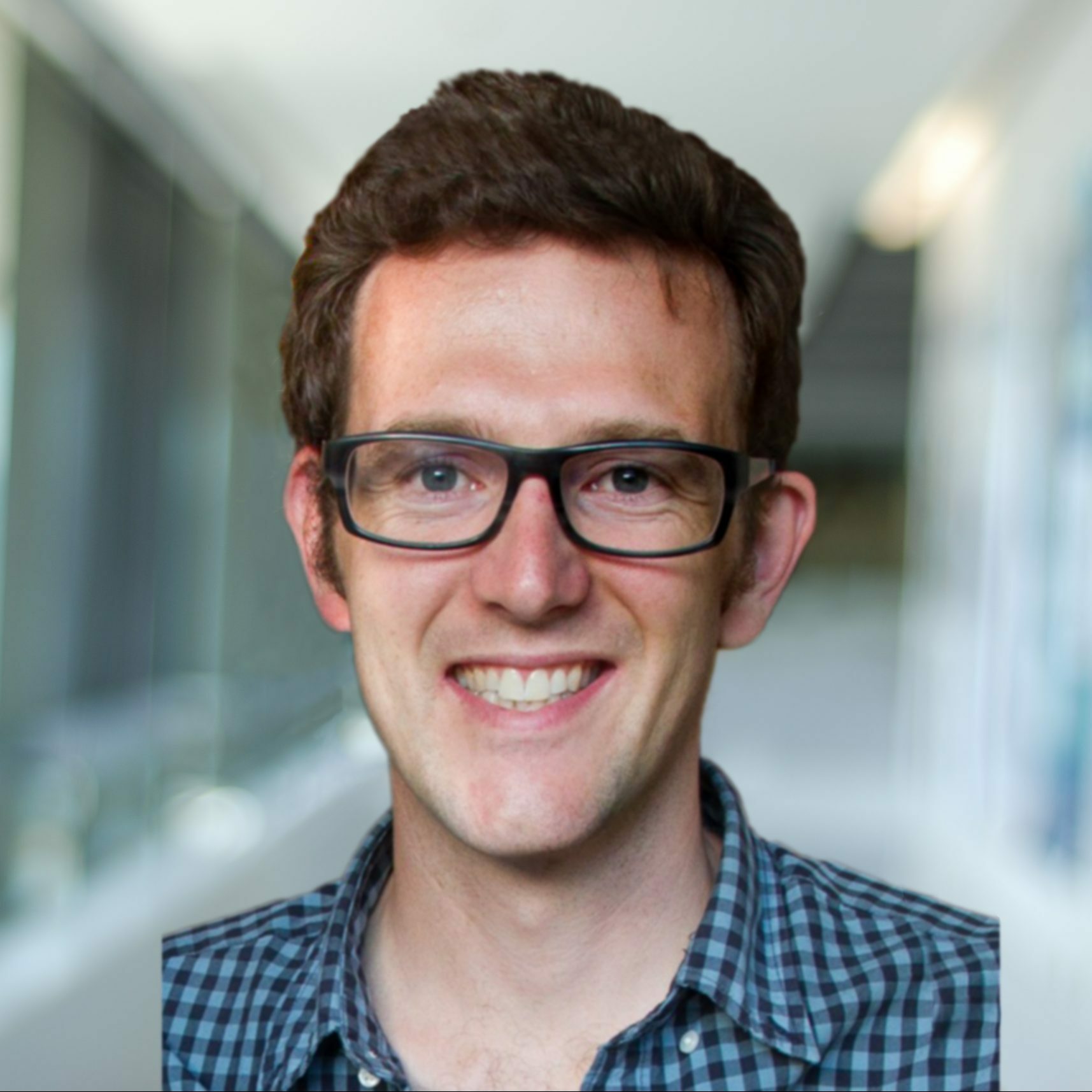
EDWARD DODDRIDGE
Physical oceanographer
(Southern Ocean change)
Simulations, Analysis and Modelling Coordinator
E: edward.doddridge@utas.edu.au
Social Links
Current AAPP Activities:
The Southern Ocean is at the centre of the global ocean. It plays a key role in regulating the exchange of heat and salt between the surface ocean and the abyss, and the transport of heat to Antarctic ice shelves. This exchange is driven by both ocean currents and sea ice. In recent years, we have witnessed dramatic reductions in the amount of sea ice that forms around Antarctica. My research uses numerical models and theory to improve our understanding of the ocean around Antarctica and its role in global climate.
Current AAPP Activities:
The Southern Ocean is at the centre of the global ocean. It plays a key role in regulating the exchange of heat and salt between the surface ocean and the abyss, and the transport of heat to Antarctic ice shelves. This exchange is driven by both ocean currents and sea ice. In recent years, we have witnessed dramatic reductions in the amount of sea ice that forms around Antarctica. My research uses numerical models and theory to improve our understanding of the ocean around Antarctica and its role in global climate.
Biography
Ed’s research focusses on the dynamics of the Southern Ocean. He uses theory, numerical models, and observations to understand the currents in the Southern Ocean, with a particular focus on the Antarctic Circumpolar Current, and the interactions between the ocean and sea ice.
Prior to joining the Australian Antarctic Program Partnership, Ed worked at the Massachusetts Institute of Technology in the USA. There he explored the dynamics of the Arctic and Southern Oceans. Ed obtained his doctorate in Physical Oceanography from the University of Oxford.
Scientific Committee Memberships
| Australian Meteorological and Oceanographic Society |
| American Geophysical Union |
Awards / Grants
| Rhodes Scholarship (Tasmania & Magdalen, 2012) |
Selected Publications
Associated links
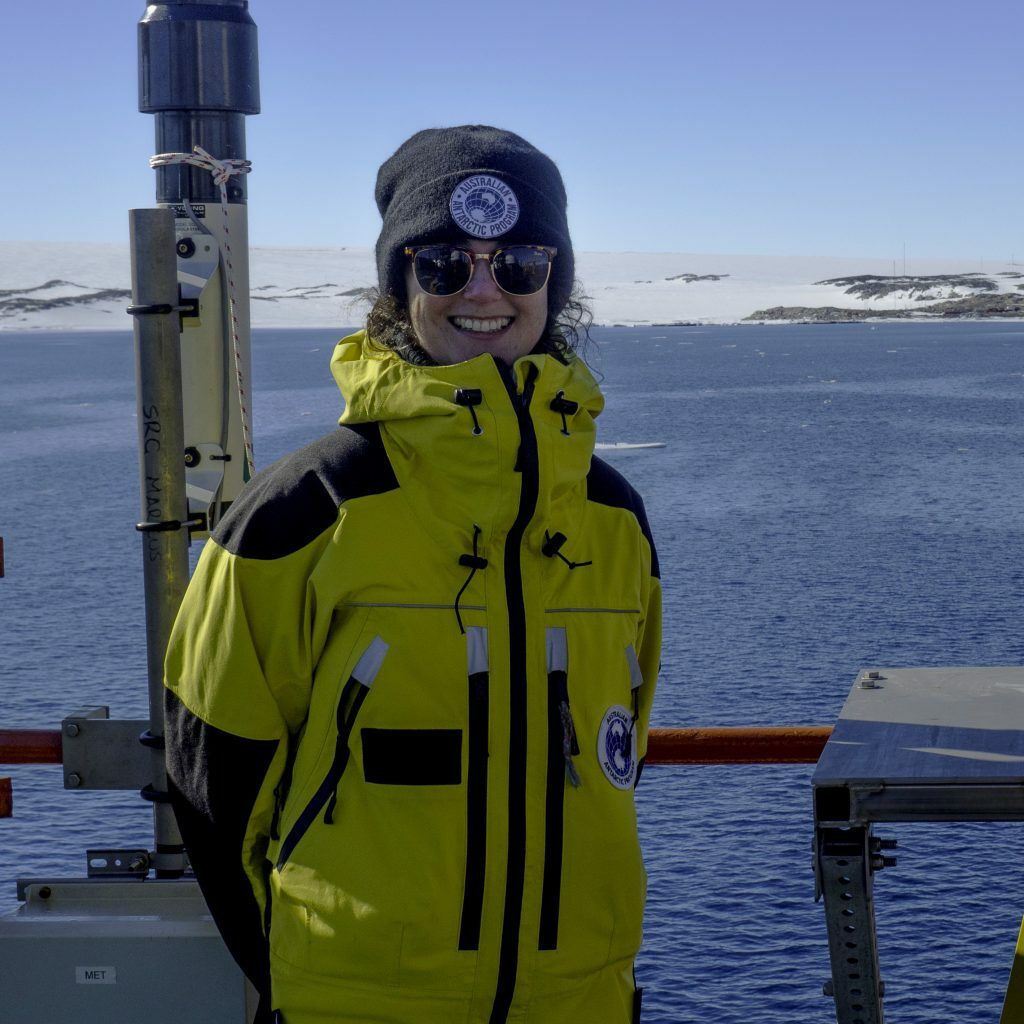
Current AAPP Activities:
Climate and weather simulations suffer from significant radiation biases over the Southern Ocean, with implications for the global energy balance and multiple aspects of the earth system. As a part of Sonya’s work with the AAPP, she will address the radiation bias in the Australian climate and weather model ACCESS, with a focus on how aerosols affect cloud properties. To do this, she will utilise the growing volume of Southern Ocean atmospheric observations to challenge the model, and identify the underlying processes that need to be improved.
Current AAPP Activities:
Climate and weather simulations suffer from significant radiation biases over the Southern Ocean, with implications for the global energy balance and multiple aspects of the earth system. As a part of Sonya’s work with the AAPP, she will address the radiation bias in the Australian climate and weather model ACCESS, with a focus on how aerosols affect cloud properties. To do this, she will utilise the growing volume of Southern Ocean atmospheric observations to challenge the model, and identify the underlying processes that need to be improved.
Biography
Sonya completed a Bachelor of Science at the University of Melbourne, followed by a Master of Science where she investigated changes in Australia’s alpine rainfall and snowfall events. After completion, Sonya undertook an internship at the Bureau of Meteorology. She then spent two years working as a research scientist on Australian weather and climate at both the University of Melbourne and the Bureau of Meteorology. Sonya completed her PhD at the University of Melbourne in 2020, where she used climate models to study the atmospheric influence of coral reef-derived dimethyl sulfide, an aerosol precursor gas, for the first time. After returning to the Bureau of Meteorology briefly after her PhD, Sonya is now a Postdoc within the Australian Antarctic Program Partnership. Sonya is also the current National Secretary of the Australian Meteorological and Oceanographic Society (AMOS). Scientific Committee Memberships
Selected Publications
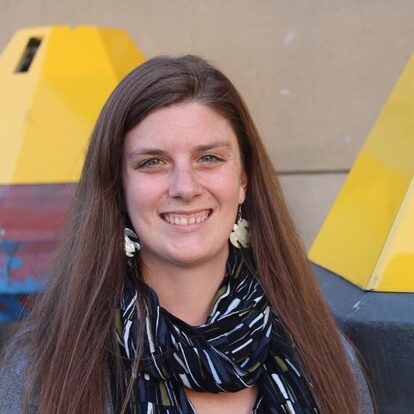
ANNIE FOPPERT
Research Associate
Physical oceanographer
(Southern Ocean circulation)
Co-leader Project 4: Oceanography
Social Links
Current AAPP Activities:
The circulation of the Southern Ocean has an outsized role in global climate by controlling how heat makes its way towards the Antarctic continent and how much anthropogenic heat and carbon are stored away in the abyssal ocean. Annie’s work with the AAPP focuses on two major themes: the influence of eddies on the Southern Ocean and the drivers of water-mass changes. Using a suite of observational data, Annie seeks to better understand the mechanisms for transporting heat across the Southern Ocean, where and how those warm waters get onto the Antarctic continental shelf, and what is responsible for changes in the deepest, densest waters in the ocean.
Current AAPP Activities:
The circulation of the Southern Ocean has an outsized role in global climate by controlling how heat makes its way towards the Antarctic continent and how much anthropogenic heat and carbon are stored away in the abyssal ocean. Annie’s work with the AAPP focuses on two major themes: the influence of eddies on the Southern Ocean and the drivers of water-mass changes. Using a suite of observational data, Annie seeks to better understand the mechanisms for transporting heat across the Southern Ocean, where and how those warm waters get onto the Antarctic continental shelf, and what is responsible for changes in the deepest, densest waters in the ocean.
Biography
Annie is a physical oceanographer interested in using a suite of observational data to better understand the dynamics, circulation, and water-mass transformations in the Southern Ocean. After completing her PhD in Oceanography from the University of Rhode Island in 2017, Annie moved to Hobart to continue researching the Southern Ocean – first at the CSIRO and now with the AAPP.
Scientific Committee Memberships
| American Geophysical Union |
| Australian Meteorological and Oceanographic Society |
| Association for the Sciences of Limnology and Oceanography |
Selected Publications

Current AAPP Activities:
Alex is involved in remote sensing of the physical properties of Antarctic sea ice, and quantifying their interactions with other elements of the physical, biological and biogeochemical environment. This includes:
Antarctic landfast sea ice mapping, and analysis of its distribution/variability.
Coastal interactions between icescape elements and the polar ocean – especially landfast sea ice-coastal polynya interaction.
Characterisation of the physical properties of Antarctic sea ice from a variety of techniques, including thickness distribution.
Marginal ice zone distribution remote retrieval.
Current AAPP Activities:
Alex is involved in remote sensing of the physical properties of Antarctic sea ice, and quantifying their interactions with other elements of the physical, biological and biogeochemical environment. This includes:
Antarctic landfast sea ice mapping, and analysis of its distribution/variability.
Coastal interactions between icescape elements and the polar ocean – especially landfast sea ice-coastal polynya interaction.
Characterisation of the physical properties of Antarctic sea ice from a variety of techniques, including thickness distribution.
Marginal ice zone distribution remote retrieval.
Biography
My first foray into Antarctic science occurred in 2006 where I undertook a research project on Antarctic polar stratospheric cloud detection and property retrieval, working under the guidance of Dr Andrew Klekociuk (Australian Antarctic Division). I graduated from my Ph.D. (University of Tasmania) in 2011, working with Dr Rob Massom on the remote sensing and analysis of East Antarctic landfast sea ice distribution and variability. This was followed by a postdoctoral appointment working on remote sensing of the Antarctic continent, with a focus on parameter retrieval from parameterisation and analysis of microwave backscatter. I then completed a two year postdoctoral fellowship in Japan (Hokkaido University, working with Prof. Kay Ohshima) working on circumpolar, high-resolution mapping of Antarctic landfast ice, with a particular focus on its interaction with sea ice production in coastal polynyas. I returned to Tasmania in 2015 to continue work on landfast sea ice remote sensing, and also developed interests in microwave remote sensing of the Antarctic sea ice, with particular applications toward remote sensing of the marginal ice zone (defined by wave-ice interaction) and sea ice thickness retrieval.
Scientific Committee Memberships
| International Glaciological Society |
| Deputy head of Sea Ice, Lake and River Ice division, International Association of Cryospheric Sciences, International Union of Geodesy and Geophysics |
| Japan Society for the Promotion of Science Alumni Association in Australia executive committee member: Tasmanian representative |
Awards / Grants
| Japan Society for the Promotion of Science postdoctoral research fellowship, 2013-2015. |
| Australian Research Council Linkage grant: “Advancing Antarctic science with a new high altitude platform capability”. |
Selected Publications
| Fraser, A. D., R. A. Massom, K. I. Ohshima, S. Willmes, P. J. Kappes, J. Cartwright & R.Porter-Smith. High-resolution mapping of circum-Antarctic landfast sea ice distribution, 2000-2018. Earth System Science Datasets Discussions (2020). |
| Fraser, A. D., K. I. Ohshima, S. Nihashi, R. A. Massom, T. Tamura, K. Nakata, G. D. Williams, S. Carpentier & S. Willmes Landfast ice controls on sea-ice production in the Cape Darnley Polynya: A case study. Remote Sensing of Environment 233 (2019). |
| Fraser, A. D., M. A. Nigro, S. R. M. Ligtenberg, B. Legrésy, M. Inoue, J. J. Cassano, P. Kuipers Munneke, J. T. M. Lenaerts, N. W. Young, A. Treverrow, M. van den Broeke & H. Enomoto. Drivers of ASCAT C band backscatter variability in the dry snow zone of Antarctica. Journal of Glaciology, 62(231):170-184 (2016). |
| Fraser, A. D., N. W. Young & N. Adams. Comparison of Microwave Backscatter Anisotropy Parameterizations of the Antarctic Ice Sheet Using ASCAT. IEEE Transactions on Geoscience and Remote Sensing, 52(3):1583-1595 (2014). |
| Fraser, A. D., R. A. Massom, K. J. Michael, B. K. Galton-Fenzi & J. L. Lieser. East Antarctic landfast sea ice distribution and variability, 2000-08. Journal of Climate, 25:1137-1156 (2012). |
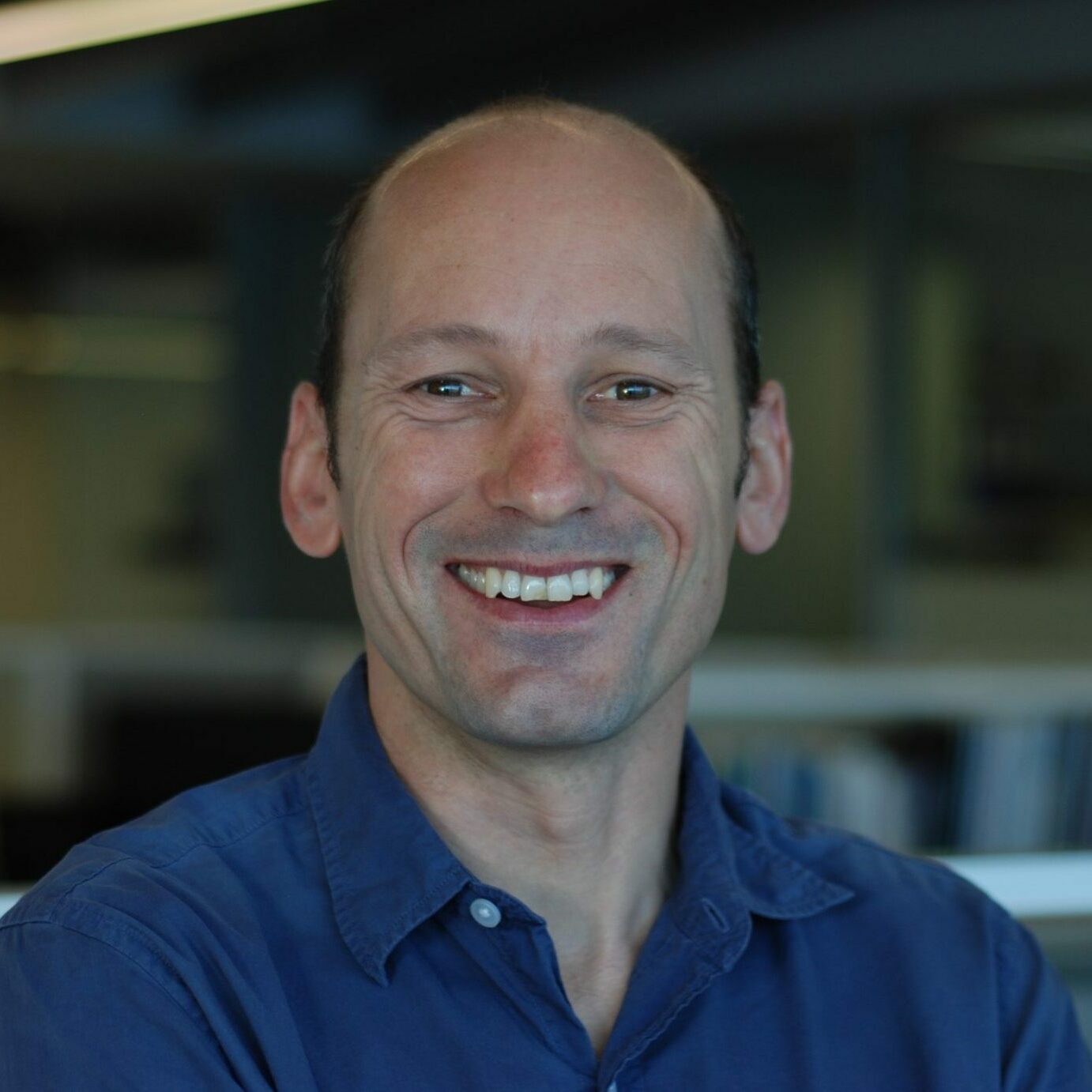
WILL HOBBS
Research Associate
Sea ice-ocean interactions scientist
Co-leader Project 6: Sea ice
Social Links
Current AAPP Activities:
Will's current research focusses on how the ocean acts as a connection between Antarctic sea ice and the global climate system. This covers two broad topics:
- The role that the ocean plays on Antarctic sea ice variability and response to anthropogenic climate change, i.e. how the ocean affects sea ice
- The role that Antarctic sea ice plays in driving the Southern Ocean, and in particular the ocean’s uptake of anthropogenic heat and carbon.
Will works with both observations and climate/ocean models. The nature of his current research, and the lack of year-round sub-surface ocean observations on the Antarctic continental shelf, means that his AAPP research primarily uses ocean-sea ice model experiments.
Current AAPP Activities:
Will's current research focusses on how the ocean acts as a connection between Antarctic sea ice and the global climate system. This covers two broad topics:
- The role that the ocean plays on Antarctic sea ice variability and response to anthropogenic climate change, i.e. how the ocean affects sea ice
- The role that Antarctic sea ice plays in driving the Southern Ocean, and in particular the ocean’s uptake of anthropogenic heat and carbon.
Will works with both observations and climate/ocean models. The nature of his current research, and the lack of year-round sub-surface ocean observations on the Antarctic continental shelf, means that his AAPP research primarily uses ocean-sea ice model experiments.
Biography
Will gained his PhD in 2009 from the University of California, Los Angeles (UCLA), where he studied the role of the atmosphere in driving large-scale variability of Southern Ocean sea ice. Following his PhD, Will was a post-doctoral researcher in the Ocean Circulation group at the NASA/Caltech Jet Propulsion Laboratory. His work at JPL involved combing satellite data with Argo float data to estimate the strength and heat transport of the Atlantic Meridional Overturning Circulation (AMOC). This ground-breaking time series is regularly updated and is widely used in the AMOC community. He came to Hobart in 2012 to take up a position in Ocean Detection and Attribution with the Institute for Marine and Antarctic Studies (IMAS), before moving to the Antarctic Climate and Ecosystems Cooperative Research Centre in March 2015, where he worked on Southern Ocean change until ACE CRC’s completion in 2019.
Over that period, his expertise on Antarctic sea ice change and variability was sought by the US National Academy of Sciences, and the Commission for Conservation of Antarctic Marine Living Resources (CCAMMLR).
Scientific Committee Memberships
| Sea Ice Prediction Network (SIPN-South) leadership team |
| Australian rapporteur, CLIVAR Southern Ocean Regional Panel (SORP) |
Awards / Grants
| Australian Research Council Discovery DP160103130 ‘Understanding spread in sea level rise projections’ |
| Australian Antarctic Science Program 4287 Ocean forced evolution of the Antarctic Ice Sheet |
| Australian Antarctic Science Program 4511 ICECAP-EAGLE |
Selected Publications
| Raphael, M. N., Marshall, G. J., Turner, J., Fogt, R. L., Schneider, D., Dixon, D. A., Hosking, J. S., Jones, J. M. & Hobbs, W. R. 2016, 'THE AMUNDSEN SEA LOW Variability, Change, and Impact on Antarctic Climate', Bulletin of the American Meteorological Society, vol. 97, no. 1, pp. 111-121 |
| William R. Hobbs, Rob Massom, Sharon Stammerjohn, Phillip Reid, Guy Williams & Walter Meier 2016, 'A review of recent changes in Southern Ocean sea ice, their drivers and forcings', Global and Planetary Change, vol. 143, pp. 228--250, doi:10.1016/j.gloplacha.2016.06.008 |
| Hobbs, Will R. & Willis, Joshua K. 2012, 'Midlatitude North Atlantic heat transport: A time series based on satellite and drifter data', Journal of Geophysical Research-Oceans, vol. 117 |
| Cunningham, Stuart A., Roberts, Christopher D., Frajka-Williams, Eleanor, Johns, William E., Hobbs, Will, Palmer, Matthew D., Rayner, Darren, Smeed, David A. & McCarthy, Gerard 2013, 'Atlantic Meridional Overturning Circulation slowdown cooled the subtropical ocean', Geophysical Research Letters, vol. 40, no. 23, pp. 6202-6207 |
| Raphael, Marilyn N. & Hobbs, Will 2014, 'The influence of the large-scale atmospheric circulation on Antarctic sea ice during ice advance and retreat seasons', Geophysical Research Letters, vol. 41, no. 14, pp. 5037-5045 |
Associated links
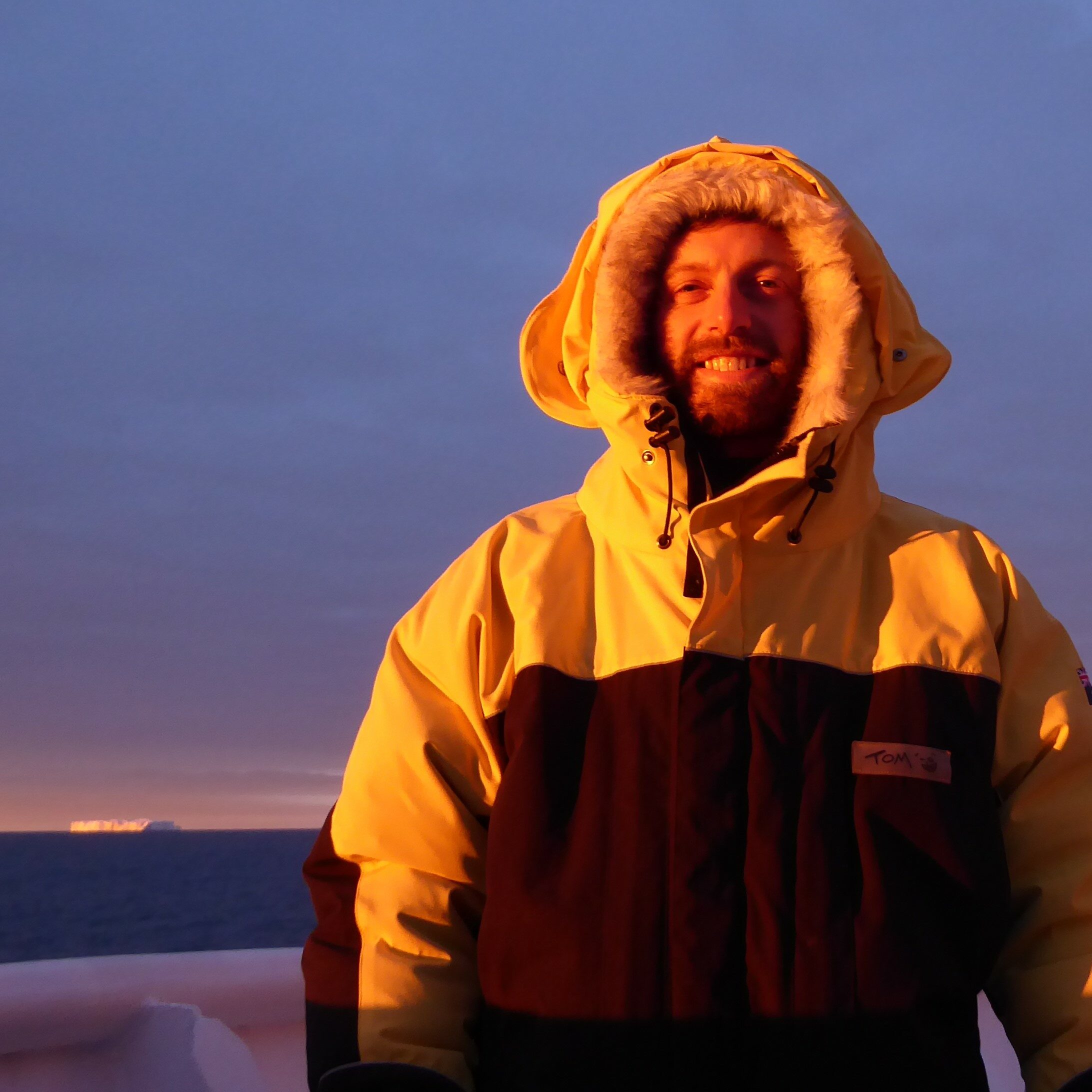
Current AAPP Activities:
Elements such as iron are essential for the growth of phytoplankton in the ocean, but in the Southern Ocean these elements are present in such low concentrations that they limit the growth of phytoplankton. The Southern Ocean is the largest of these regions and plays a key role in climate regulation but remains relatively understudied. Tom examines trace element biogeochemistry in the Southern Ocean by identifying the sources, sinks and biological cycling of iron (and fingerprint trace metals) as the controlling element of Southern Ocean productivity.
Current AAPP Activities:
Elements such as iron are essential for the growth of phytoplankton in the ocean, but in the Southern Ocean these elements are present in such low concentrations that they limit the growth of phytoplankton. The Southern Ocean is the largest of these regions and plays a key role in climate regulation but remains relatively understudied. Tom examines trace element biogeochemistry in the Southern Ocean by identifying the sources, sinks and biological cycling of iron (and fingerprint trace metals) as the controlling element of Southern Ocean productivity.
Biography
Tom is a trace element biogeochemist who researches the sources, sinks and cycling of iron and other trace elements in the ocean. He aims to improve our current understanding of what currently drives or limits the productivity of primary producers in the ocean so that we may better predict how these processes may change under future changing climate conditions.
Previously, Tom completed a postdoc at the University of Washington, USA, measuring the impact of episodic glacial dust trace element inputs from glacial valleys into the Gulf of Alaska. He completed a PhD at IMAS, focused on the impact of volcanism on trace metal biogeochemistry in the Southern Ocean.
Selected Publications
Holmes, T.M., Wuttig, K., Chase, Z., Schallenberg, C., Merwe, P., Townsend, A.T., Bowie, A.R., 2020. Glacial and Hydrothermal Sources of Dissolved Iron (II) in Southern Ocean Waters Surrounding Heard and McDonald Islands. J. Geophys. Res. Ocean. 125, 1–16. doi:10.1029/2020JC016286 |
Holmes, T.M., Wuttig, K., Chase, Z., van der Merwe, P., Townsend, A.T., Schallenberg, C., Tonnard, M., Bowie, A.R., 2019. Iron availability influences nutrient drawdown in the Heard and McDonald Islands region, Southern Ocean. Mar. Chem. 211, 1–14. doi:10.1016/j.marchem.2019.03.002 |
Holmes, T.M., Chase, Z., Van Der Merwe, P., Townsend, A.T., Bowie, A.R., 2017. Detection, dispersal and biogeochemical contribution of hydrothermal iron in the ocean. Mar. Freshw. Res. 68, 2184–2204. doi:10.1071/MF16335 |
Wuttig, K., Townsend, A.T., van der Merwe, P., Gault-Ringold, M., Holmes, T., Schallenberg, C., Latour, P., Tonnard, M., Rijkenberg, M.J.A., Lannuzel, D., Bowie, A.R., 2019. Critical evaluation of a seaFAST system for the analysis of trace metals in marine samples. Talanta 197, 653–668. doi:10.1016/j.talanta.2019.01.047 |
van der Merwe, P., Wuttig, K., Holmes, T., Trull, T.W., Chase, Z., Townsend, A.T., Goemann, K., Bowie, A.R., 2019. High Lability Fe Particles Sourced From Glacial Erosion Can Meet Previously Unaccounted Biological Demand: Heard Island, Southern Ocean. Front. Mar. Sci. 6, 1–20. doi:10.3389/fmars.2019.00332 |
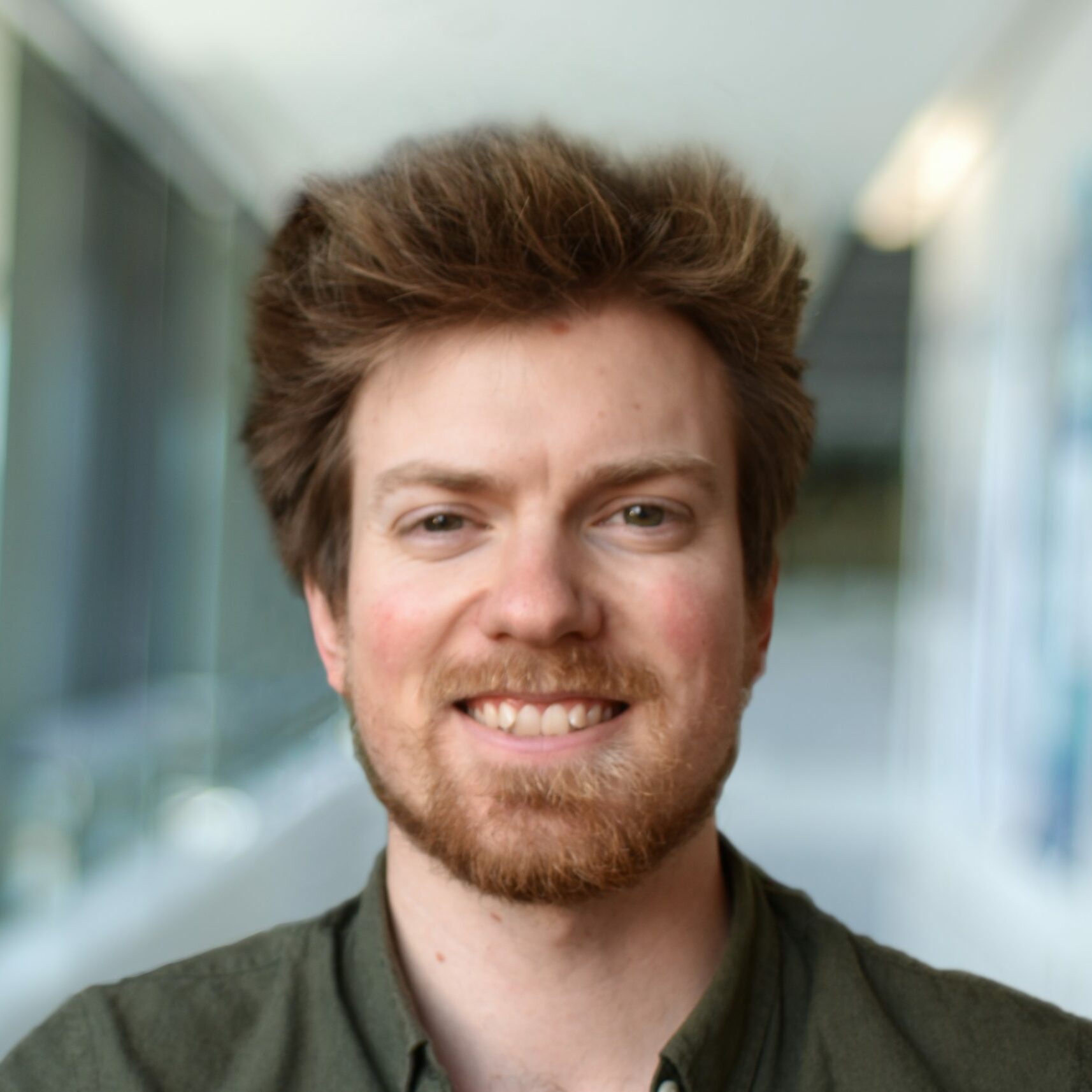
Current AAPP Activities:
I am working within the Atmosphere project of AAPP’s Theme 1, Antarctica’s Influence on Climate and Sea Level. My role is to synthesise observations of clouds and aerosols from several recent measurement campaigns in the Southern Ocean, evaluate the most important processes that influence the radiative energy budget, and plan and evaluate future model simulations. Most models have a persistent short-wave radiation bias over the Southern Ocean. Addressing this short-wave radiation bias issue using the Australian Community Climate and Earth-System Simulator (ACCESS) model is my primary objective as an atmospheric scientist within the AAPP.
Current AAPP Activities:
I am working within the Atmosphere project of AAPP’s Theme 1, Antarctica’s Influence on Climate and Sea Level. My role is to synthesise observations of clouds and aerosols from several recent measurement campaigns in the Southern Ocean, evaluate the most important processes that influence the radiative energy budget, and plan and evaluate future model simulations. Most models have a persistent short-wave radiation bias over the Southern Ocean. Addressing this short-wave radiation bias issue using the Australian Community Climate and Earth-System Simulator (ACCESS) model is my primary objective as an atmospheric scientist within the AAPP.
Biography
I studied a Bachelor of Applied Science (Physics) at the Queensland University of Technology. I continued at QUT and completed a PhD in atmospheric science, investigating the role of aerosol emissions as cloud condensation nuclei over the Great Barrier Reef and from fires in northern Australia.
After this I moved to France for just over two years and worked in two laboratories as a postdoctoral scientist in association with the French National Centre for Scientific Research and the French National Centre for Spatial Studies. Over those two years I investigated atmospheric aerosols and their transport in the Arctic, the Mediterranean and the southeast Atlantic and southern Africa.
Upon returning to Australia in 2019, I worked briefly for the Defence Science and Technology Group evaluating the performance of low-cost air quality sensors before taking up my current role as an atmospheric scientist within the AAPP at IMAS and the University of Tasmania. My main interest now is investigating aerosol-cloud-radiation interactions over the Southern Ocean.
Awards / Grants
| (2017) CNES Postdoctoral Grant, Bridging in-situ observations, remote sensing and model simulations of aerosol over the southeast Atlantic, 2-year salary |
| (2013) Australian Postgraduate Award, Water uptake and composition of natural Australian cloud condensation nuclei, 3-year stipend |
Selected Publications
| Mallet, Marc D., et al. "Biomass burning emissions in north Australia during the early dry season: an overview of the 2014 SAFIRED campaign." Atmospheric Chemistry and Physics 17.22 (2017): 13681-13681. |
| Formenti, P., D’Anna, B., Flamant, C., Mallet, M., Piketh, S. J., Schepanski, K., ... & Chaboureau, J. P. The aerosols, radiation and clouds in Southern Africa field campaign in Namibia: overview, illustrative observations, and way forward. Bulletin of the American Meteorological Society, 100(7), (2019): 1277-1298. |
| Mallet, Marc D., et al. "Composition, size and cloud condensation nuclei activity of biomass burning aerosol from northern Australian savannah fires." Atmospheric Chemistry and Physics 17 (2017): 3605-3617. |
| Mallet, Marc D., et al. "Summertime surface PM 1 aerosol composition and size by source region at the Lampedusa island in the central Mediterranean Sea." Atmospheric Chemistry and Physics 19.17 (2019): 11123-11142. |
| Wang, X., Thai, P. K., Mallet, M., Desservettaz, M., Hawker, D. W., Keywood, M., ... & Mueller, J. F. Emissions of selected semivolatile organic chemicals from forest and savannah fires. Environmental science & technology, 51(3), (2017): 1293-1302. |
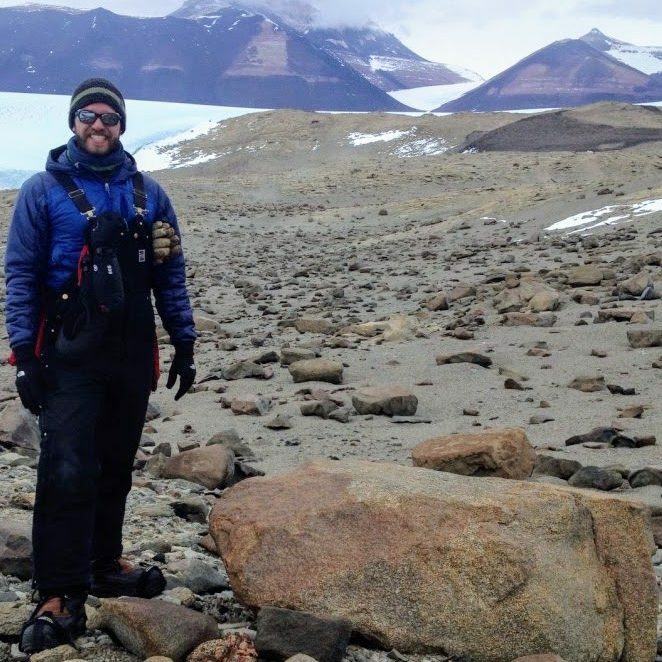
ANDY MENKING
Research Associate
Palaeoclimatologist
Co-leader Project 2: Ice Cores
Current AAPP Activities:
Greenhouse gases are rapidly increasing in the modern atmosphere, causing substantial global warming. To put the modern changes in context, we need to know how greenhouse gases varied prior to industrialization and what processes controlled them. As an AAPP Ice Cores Research Associate, Andy measures stable isotopes of carbon dioxide and nitrous oxide in ice core air bubbles. Combined with modelling, the data quantify variations in the past and constrain the processes that were responsible.
Current AAPP Activities:
Greenhouse gases are rapidly increasing in the modern atmosphere, causing substantial global warming. To put the modern changes in context, we need to know how greenhouse gases varied prior to industrialization and what processes controlled them. As an AAPP Ice Cores Research Associate, Andy measures stable isotopes of carbon dioxide and nitrous oxide in ice core air bubbles. Combined with modelling, the data quantify variations in the past and constrain the processes that were responsible.
Biography
Andy’s research interests are focused on the relationship between climate and biogeochemical cycles. Andy uses geochemical data from ice cores combined with modelling approaches to understand what processes in the carbon and nitrogen cycles caused trace greenhouse gases to vary in the past.
Andy attended Oregon State University for his Ph.D. where he studied the reasons why greenhouse gas concentrations decreased substantially at the beginning of the last ice age. Prior to this, Andy got a Masters degree at Central Washington University studying soot particles in ice cores.
Selected Publications
| Shackleton, S., Menking, J.A., Brook, E., Buizert, C., Dyonisius, M., Petrenko, V., Baggenstos, D., Severinghaus, J., 2021. Evolution of mean ocean temperature in Marine Isotope Stage 4. Climate of the Past 17, 2273-2289. |
| Menking, J.A., Brook, E.J., Schilt, A., Shackleton, S., Dyonisius, M., Severinghaus, J.P., Petrenko, V.V., 2020. Millennial-Scale Changes in Terrestrial and Marine Nitrous Oxide Emissions at the Onset and Termination of Marine Isotope Stage 4. Geophysical Research Letters 47, 13. |
| Menking, J.A., Brook, E.J., Shackleton, S.A., Severinghaus, J.P., Dyonisius, M.N., Petrenko, V., McConnell, J.R., Rhodes, R.H., Bauska, T.K., Baggenstos, D., Marcott, S., Barker, S., 2019. Spatial pattern of accumulation at Taylor Dome during Marine Isotope Stage 4: stratigraphic constraints from Taylor Glacier. Climate of the Past 15, 1537-1556. |
| Wendl, I.A., Menking, J.A., Farber, R., Gysel, M., Kaspari, S.D., Laborde, M.J.G., Schwikowski, M., 2014. Optimized method for black carbon analysis in ice and snow using the Single Particle Soot Photometer. Atmospheric Measurement Techniques 7, 2667-2681. |
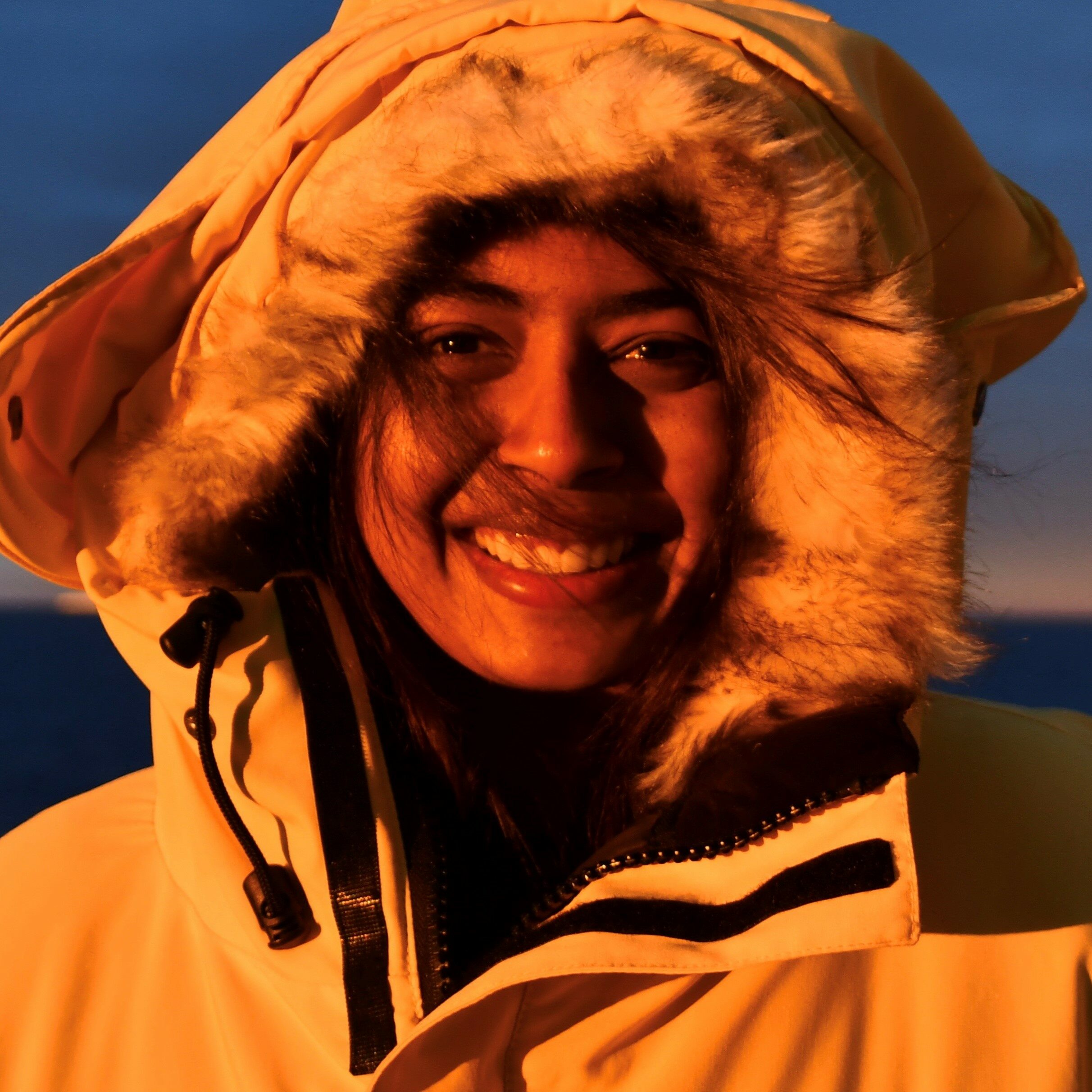
LAVENIA RATNARAJAH
Research Associate
Carbon biogeochemist
E: lavenia.ratnarajah@utas.edu.au
Social links
Current AAPP Activities:
The ocean’s ability to sequester carbon away from the atmosphere exerts an important control on global climate. However, our conceptual understanding of how nutrients and carbon are cycled in the ocean at present is incomplete. My research goal is to understand the biological, chemical and physical processes that influence current and future patterns of phytoplankton production and carbon export, and the flow-on effects to ocean productivity. Quantifying where iron and carbon are stored, in what form, and the fluxes between these reservoirs, are vital for understanding climate-driven impacts at present and predicting future changes.
My current role covers two areas:
- What are the effects of eddy-driven subduction on carbon export?
- Can the southward movement of the sub-tropical front provide an analogue to future ocean warming and what are the implications for carbon export?
I was also recently awarded an ARC Discovery Project to examine how zooplankton shape the response of ocean productivity in a changing climate.
Current AAPP Activities:
The ocean’s ability to sequester carbon away from the atmosphere exerts an important control on global climate. However, our conceptual understanding of how nutrients and carbon are cycled in the ocean at present is incomplete. My research goal is to understand the biological, chemical and physical processes that influence current and future patterns of phytoplankton production and carbon export, and the flow-on effects to ocean productivity. Quantifying where iron and carbon are stored, in what form, and the fluxes between these reservoirs, are vital for understanding climate-driven impacts at present and predicting future changes.
My current role covers two areas:
- What are the effects of eddy-driven subduction on carbon export?
- Can the southward movement of the sub-tropical front provide an analogue to future ocean warming and what are the implications for carbon export?
I was also recently awarded an ARC Discovery Project to examine how zooplankton shape the response of ocean productivity in a changing climate.
Biography
My PhD research focussed on the recycling of iron by marine animals in the Southern Ocean. Following my graduation in 2017, I undertook a 1-year postdoctoral fellowship in microbial ecology and carbon export around marginal ice zones in Australia, followed by a 3-month SCAR Fellowship in France. I then undertook a ~3-year postdoctoral fellowship in biogeochemical modelling in the UK. Over the COVID period, I transitioned to a 2-year science management role as the program lead for the Biology and Ecosystems panel of the Global Ocean Observing System (GOOS), IOC-UNESCO followed by a 6-month maternity cover for the Southern Ocean Observing System. I returned to full-time research in May 2023 as a carbon biogeochemist with the Australian Antarctic Program Partnership.
Selected Publications
| Ratnarajah L, Abu-Alhaija R, Atkinson A, Aumont O, Batten S, Bax N, Bernard K, Canonico G, Cornils A, Everett J, Grigoratou M, Irrison J-O, Ishak NHA, Johns D, Kudela R, Lombard F, Muller-Karger F, Muxagata E, Ostle C, Pitois S, Richardson A, Schmidt K, Stemmann L, Swadling K, Yang G, Yebra L (2023) Monitoring and modelling zooplankton in a changing climate. Nature Communications. |
| Ratnarajah L, Puigcorbé V, Moreau S, Janssens J, Corkill M, Duprat L, Genovese C, Roca-Marti M, Lieser J, Masqué P, Lannuzel D (2022) Distribution and export of particulate organic carbon in East Antarctic coastal polynyas. Journal of Geophysical Research Oceans. |
| Ratnarajah L, Blain S, Boyd P, Obernosterer I, Fourquez M, Tagliabue A (2021) Resource co-limitation drives competition between phytoplankton and bacteria in the Southern Ocean. Geophysical Research Letters. 48 (1): 1-11. |
| Cavan E, Belcher A, Atkinson A, Hill SL, Kawaguchi S, McCormack S, Meyer B, Nicol S, Ratnarajah L, Schmidt K, Steinberg DK, Tarling GA, Boyd P (2019) The importance of Antarctic krill in biogeochemical cycles. Nature Communications. 10 (1): 1-13. |
| Smith AJR, Ratnarajah L, Holmes T, Wuttig K, Townsend AT, Westwood K, Cox M, Bell E, Nicol S, Lannuzel D (2021) Circumpolar Deep Water and shelf sediments support late summer microbial iron remineralisation. 35 (11): 1-10. Global Biogeochemical Cycles. |
Significant awards/grants
| Australian Research Council Discovery Project 2023 |
| Institute for Marine and Antarctic Studies award for Best PhD Thesis 2017 |
| SCAR Fellowship to Laboratoire d’Océanographie Microbienne CNRS/UPMC, France 2016 |
| University of Tasmania Central Science Laboratory Peter W. Smith Postgraduate Award 2015 |
| Holsworth Wildlife Research Endowment 2014-2016 |

TYLER ROHR
Research Associate
Carbon biogeochemist
Current AAPP Activities:
With AAPP my work focusses on biogeochemical cycling in the sub-Antarctic zone. I use in-situ observations from the Southern Ocean Time Series, in conjunction with remote sensing and modelling data, to better understand the role of the region in the context of broader Southern Ocean carbon cycling and a changing climate.
Current AAPP Activities:
With AAPP my work focusses on biogeochemical cycling in the sub-Antarctic zone. I use in-situ observations from the Southern Ocean Time series, in conjunction with remote sensing and modelling data, to better understand the role of the region in the context of broader Southern Ocean carbon cycling and a changing climate.
Biography
I am broadly interested in biogeochemistry and carbon cycling spanning scales from the interaction between phytoplankton and eddies at the mesoscale to changes in net primary production following global scale climate disturbances. While my work focuses on the underlying mechanisms that regulate marine productivity I am also very interested in the broader societal implications of oceanic carbon cycling amidst a changing climate.
I first learned how to leverage my engineering education to tackle broad questions in biogeochemistry as an undergraduate at Duke University. Backed by competitive financial support, awarded as a Pratt Research Fellowship, I modelled rainfall variability and seasonal carbon cycling to help inform land-use management in drought prone regions. After graduating with departmental distinction I secured external competitive funding in the form of an NDSEG Fellowship to pursue my Ph.D. in the MIT/WHOI Joint Program.
During graduate school I began to investigate how vertical mixing controls phytoplankton bloom phenology in the Southern Ocean, from both a bottom-up and top-down perspective. I found strong evidence in a Community Earth System Model simulation, and implicit support in the remote sensing record, that blooms can initiate amidst both strong and weak cell division rates depending on iron and light availability, and trophic decoupling.
During the later half of my doctorate, my research shifted to the explicit role of mesoscale eddies in driving phytoplankton ecosystem dynamics. From a bottom-up perspective, I found that Eddy-induced Ekman pumping is the dominant iron transport mechanism in simulated eddies, and in turn is the primary driver of eddy modified division rates throughout most of the year. One exception occurs in deep winter mixing periods when eddy modified light availability instead dominates. The ultimate effect on anomalous biomass, however, is complicated by other physical and biological pathways, resulting in striking seasonal and regional variability in the direction of anomalies and mechanisms that drive them.
After completing my doctorate I continued to work as an independent researcher to help investigate how a global nuclear conflict, and subsequent changes to oceanic light and nutrient availability, would effect marine biogeochemistry and productivity.
Finally, throughout my career I have sought place my work in a broader societal and political context. To this end, I have completed a fellowship at the US Department of Energy working at the intersection of ocean policy, renewable energy, ocean observing systems; co-chaired the 2015 Graduate Climate Conference; completed a graduate Certificate in Science Technology and Policy at MIT; published a policy paper on Ocean Iron Fertilization; and attended various ocean policy conferences and workshops.
Awards / Grants
| Knauss Fellowship (Woods Hole Seagrant) |
| NDSEG Fellowship (US DOD) |
| NSF GRFP Honorable Mention (2x) (US NSF) |
| Pratt Undergraduate Research Fellowship (Duke University) |
| Duke Engage Fellowship (Duke University) |
Selected Publications

ROBERT STRZEPEK
Research Associate
Phytoplankton ecologist
Co-leader Project 7: Krill and ecosystems
E: robert.strzepek@utas.edu.au
Social Links
Current AAPP Activities:
I lead research on defining the traits and likely responses of Antarctic primary producers to observed and predicted changes in the Southern Ocean, and the effects these may have on marine carbon and nutrient cycling.
Current AAPP Activities:
I lead research on defining the traits and likely responses of Antarctic primary producers to observed and predicted changes in the Southern Ocean, and the effects these may have on marine carbon and nutrient cycling.
Biography
I received a PhD in Botany and Oceanography in 2003 from the University of British Columbia, Vancouver, Canada and a BSc in Biology (Major in Marine Biology) from McGill University, Montréal, Canada. I worked as a postdoctoral researcher at the University of Otago, Dunedin, New Zealand (2001-2011), and as a Research Fellow at the Research School of Earth Sciences at the Australian National University (2012-2016). I have worked at IMAS since 2016.
As a quantitative phytoplankton ecophysiologist, I couple trace metal clean environmental manipulation laboratory studies with ocean-going voyages to address fundamental questions in phytoplankton physiology and ecology and aspects of ocean biogeochemistry, such as the adaptations of Southern Ocean phytoplankton to the particular constraints imposed by their environment, the role of the marine biota in the cycling of major nutrients and trace metals in the Southern Ocean, and the physiological responses of Southern Ocean phytoplankton to projected changes in their climate.
In the lab, my colleagues and I provided the first biochemical explanation for the lower iron requirements of oceanic diatoms compared to their coastal cousins (Strzepek and Harrison 2004) and that Southern Ocean phytoplankton species, in particular, have converged on a similar evolutionary strategy whereby they need much less iron for photosynthesis than phytoplankton from warmer waters (Strzepek et al. 2011, 2012). A subsequent detailed biochemical analysis published in PNAS (Strzepek et al. 2019) provided a mechanistic explanation for the combined effects of iron, light and temperature in shaping this evolutionary trajectory. I am currently working with modellers to incorporate these novel photophysiological responses into biogeochemical models and in the future trait-based ecosystem models, and conducting further laboratory manipulation experiments (temperature/iron/light) to couple physiological and whole cell protein expression responses.
In parallel with my laboratory work, I routinely go on research voyages to quantify particular aspects of phytoplankton ecology and biogeochemistry, such as the environmental forcings on the marine biogeochemical cycles of carbon and iron.
Scientific Committee Memberships
| (April 2020 – present) Project Leader for the ‘Ecosystems’ Research Project within Theme 3 of the Australian Antarctic Program Partnership (AAPP) |
| (Nov. 2018 – present) Member of the planning committee and the Australian representative of BioGeoSCAPES, a new multi-year global study of ocean metabolism regulators and their interactions with nutrient cycles. |
Awards / Grants
| 2012. Australian Research Council Discovery Project: 130100679 “Probing the response of Southern Ocean phytoplankton to changes in iron biogeochemistry, light and pH associated with climate change” (with M. Ellwood, P. Boyd, B. Maher, and B. Nunn). |
| 2011. New Zealand Prime Minister’s Prize for Science (with 8 others). |
| 2005-2008. New Zealand Science and Technology Post-Doctoral Fellowship (Foundation for Research Science and Technology (FRST). |
Selected Publications
| Strzepek, RF, Boyd, PW, and WG Sunda (2019) Photosynthetic adaptation to low iron, light, and temperature in Southern Ocean phytoplankton. PNAS 116 (10), 4388-4393, https://doi.org/10.1073/pnas.1810886116 |
| Nunn, BL, Faux, JF, Hippmann, AA, Maldonado, MT, Harvey, HR, Goodlett, DR, Boyd, PW, and Strzepek, RF (2013) Diatom Proteomics Reveals Unique Acclimation Strategies to Mitigate Fe Limitation. PLoS ONE, 8, art. no. e75653, https://doi.org/10.1371/journal.pone.0075653 |
| Strzepek, RF, Hunter, KA, Frew, RD, Harrison, PJ, and Boyd, PW. (2012) Iron-light interactions differ in Southern Ocean phytoplankton. Limnol. Oceanogr. 57: 1182-1200. https://doi.org/10.4319/lo.2012.57.4.1182 |
| Strzepek, RF, Maldonado, MT, Hunter, KA, Frew, RD, and Boyd, PW (2011) Adaptive strategies by Southern Ocean phytoplankton to lessen iron limitation: Uptake of organically complexed iron and reduced cellular iron requirements. Limnol. Oceanogr. 56: 1983-2002. https://doi.org/10.4319/lo.2011.56.6.1983 |
| Strzepek, RF, Harrison, PJ (2004) Photosynthetic architecture differs in coastal and oceanic diatoms. Nature 431: 689-692. doi: 10.1038/nature02954 |
Associated links
https://publons.com/researcher/1230187/robert-francis-strzepek/
https://www.scopus.com/authid/detail.uri?authorId=55887987700
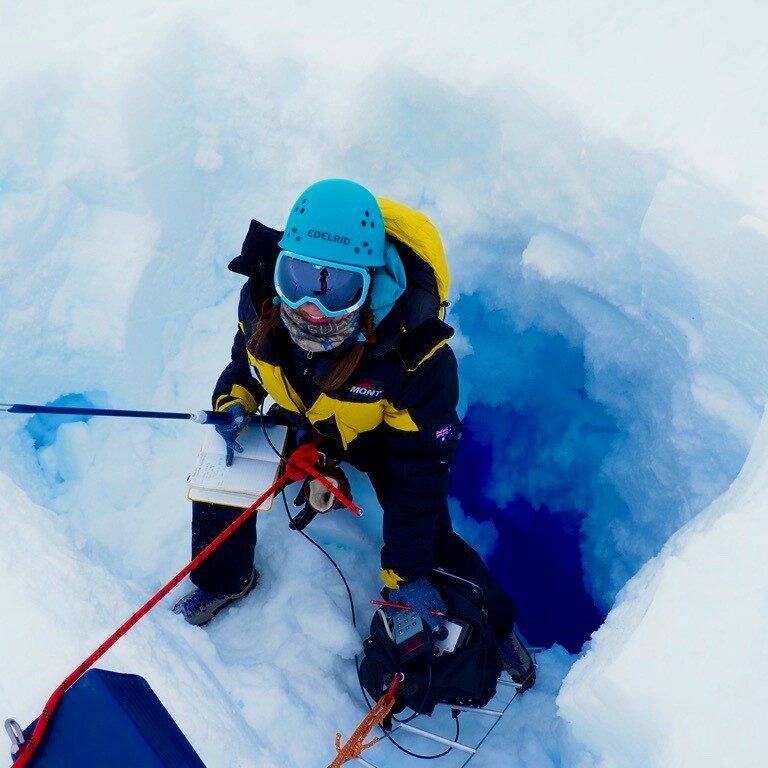
SARAH THOMPSON
Research Associate
Glaciologist (remote sensing)
Co-leader Project 3: Ice shelves
Social Links
Current AAPP Activities:
My role within the AAPP is part of the project focusing on ice shelves and their role in the contribution of the East Antarctic ice sheet to future sea level rise. I use remote, airborne and field data to investigate factors affecting ice shelf stability, particularly characterising ice fracture and snow and ice properties.
Current AAPP Activities:
My role within the AAPP is part of the project focusing on ice shelves and their role in the contribution of the East Antarctic ice sheet to future sea level rise. I use remote, airborne and field data to investigate factors affecting ice shelf stability, particularly characterising ice fracture and snow and ice properties.
Biography
I am a research scientist and educator specialising in glaciology, satellite remote sensing and applied geophysics. Broadly my research focuses on identifying and investigating the hazards associated with glaciers, ice sheets and snowpacks in a changing climate. Particularly in developing and adapting geophysical approaches to allow the prediction of hazards in the natural environments, and the assessment of risk to society on a global and local scale.
I completed my PhD at the University of Swansea in 2012, focusing on early recognition and mitigation of glacial lake outburst hazards in the Himalayas. Since then I have had the opportunity to work as a post-doctoral researcher at ETH in Switzerland, the University of Innsbruck in Austria and attained two post-doctoral research fellowships to work at the University Centre in Svalbard and Swansea University. I have been working at the Institute of Marine and Antarctic Studies in Hobart since January 2019, focusing on developing remote and field-based techniques applied to glacier crevasse detection for scientific and field safety applications.
In my professional life I have been fortunate enough to gain significant experience living and operating in remote, logistically difficult and high-altitude environments. Having participated in, and organised extensive fieldwork in Svalbard, the European Alps the Himalayas, and most recently three summer seasons in East Antarctica with the Australian Antarctic Division.
Scientific Committee Memberships
| International Geographical Society |
| American Geophysical Union |
| European Geophysical Union |
| Royal Geographical Society |
Awards / Grants
| 2016 - AXA Research Fund Post-Doctoral Fellowship |
| 2014 - Marie Curie Intra European Fellowship |
Selected Publications
| Thompson, S.S., Cook, S.J., Winberry, P., Fraser, A., Galton-Fenzi, B. and Kulessa, B. (2020) Comparing satellite and helicopter based radar methods of crevasse detection for field safety applications, Cold Regions Science and Technology. Accepted |
| Thompson, S.S., Kulessa, B., Benn, D.I. & Mertes, J.R. (2017) Anatomy of terminal moraine segments and implied lake stability on Ngozumpa Glacier Nepal, from electrical resistivity tomography (ERT), Scientific Reports, 7:46766, doi: 10.1038/srep46766. |
| Thompson, S.S., Benn, D.I., Mertes, J.R. and Luckman, A. (2016) Stagnation and Mass Loss on a Himalayan Debris-covered Glacier: Processes, Patterns and Rates, Journal of Glaciology, 62(233), 467-485, doi:10.1017/jog.2016.37. |
| Thompson, S.S., Kulessa, B., Essery, R.L.H., and Lüthi, M.P. (2016), Bulk meltwater flow and liquid water content of snowpacks mapped using the electrical self-potential (SP), method The Cryosphere, 10, 433-444, doi:10.5194/tc-10-433-2016. |
| Thompson, S.S., Kulessa, B. and Luckman, A. (2012), Integrated electrical resistivity tomography (ERT) and self-potential (SP) techniques for assessing hydrological processes within glacial lake moraine dams, Journal of Glaciology, 58 (211), 849-858, doi: 0.3189/2012JoG11J235. |
Associated links
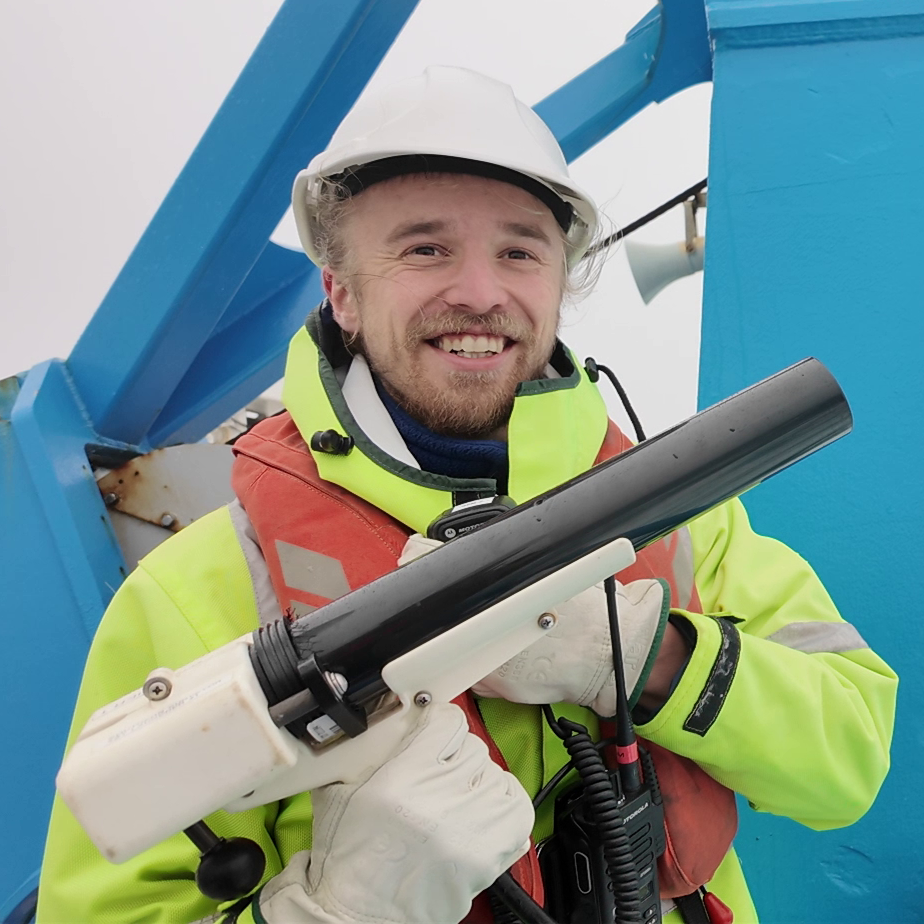
YANN-TREDEN TRANCHANT
Research Associate
Physical oceanographer
(satellite altimetry)
E: yanntreden.tranchant@utas.edu.au
Social Links
Current AAPP Activities:
I am a physical oceanographer with a strong interest in satellite altimetry. Most of my work is to combine satellite altimetry datasets with model outputs and in situ observations. My PhD research was on the French Atlantic coast to investigate coastal limitations of altimetry data.
My PhD was related to designing methodologies to meet the technical challenges of the new SWOT satellite in coastal areas. With SWOT launched after my PhD was completed in 2021, I’m now focusing on its application to climate-related research in the Southern Ocean and open-ocean dynamics.
Current AAPP Activities:
I am a physical oceanographer with a strong interest in satellite altimetry. Most of my work is to combine satellite altimetry datasets with model outputs and in situ observations.
Biography
I’m an early-career researcher during a period of major technological and scientific advances in the field of satellite altimetry. In November-December 2023, I participated in my first oceanographic voyage, the FOCUS voyage on Australian CSIRO research vessel RV Investigator (part of the SWOT-AdAC campaign). For the first time, I experienced first-hand how oceanographic data is collected and making observations with ship-borne instruments, in particular, being part of a team sampling a large number of CTD rosettes (a total of 111 CTD casts in one five-week voyage). After years of processing data, it was exciting to ‘feel the physics’ of the ocean in a high-energy zone of the Antarctic Circumpolar Current. This greatly helps my understanding in using data and modelling frameworks. I appreciate how the SWOT-AdaC campaign is bringing ocean physics to life.
I am with the Australian Antarctic Program Partnership as a Research Associate until 2026. In my new-found relationship with the Southern Ocean, I am discovering different types of physics. Surrounded by brilliant scientists and technicians and wonderful technology, I am both absorbing new fields and infusing them with my own training. Against a background of dramatic change and exposed to constant data flow, I want to put things together in an integrated and open way. By helping to fill the gaps in the complex story of the role of the Southern Ocean in the global climate system, I hope to make meaningful contributions to climate-related research into poleward heat transport to Antarctic ice shelves.

TESSA VANCE
Research Associate
Australian and Antarctic palaeoclimatology
Impacts and Communications Coordinator
Social Links
Current AAPP Activities:
Tessa's AAPP role is developing ice core records of climate for the southwest Pacific and southern Indian Ocean from ice core archives. The ice cores have been drilled in regions of East Antarctica that border the southern Indian and Pacific Oceans, both of which have very few long meteorological records. These palaeoclimate records aid in extending and quantifying the climate and weather variability stemming from this region. In addition, she collaborates closely with hydrologists and water resources managers to use these long records to better assess hydroclimate risks for Australia.
Current AAPP Activities:
Tessa's AAPP role is developing ice core records of climate for the southwest Pacific and southern Indian Ocean from ice core archives. The ice cores have been drilled in regions of East Antarctica that border the southern Indian and Pacific Oceans, both of which have very few long meteorological records. These palaeoclimate records aid in extending and quantifying the climate and weather variability stemming from this region. In addition, she collaborates closely with hydrologists and water resources managers to use these long records to better assess hydroclimate risks for Australia.
Biography
Tessa develops high resolution palaeoclimate records with a view to understanding long-term climate variability and change. She has a particular interest in developing palaeoclimate records that describe the southwest Pacific and southern Indian Ocean regions over the recent centuries using ice core records from East Antarctica. These records also contribute to defining the underlying climate processes and variability from these regions that affect rainfall variability in Australia. She also develops drought and rainfall records for Australia spanning the last 1-2 thousand years in collaboration with hydrologists and water resources managers.
Scientific Committee Memberships
| AMOS (Australian Meteorological and Oceanographic Society) |
| AQUA (Australian Quaternary Society) |
| EGU and AGU (European and American Geophysical Unions) |
Awards / Grants
| Chief Investigator, Australian Antarctic Science Project 4414: Mount Brown South Ice Core ($1,093,000, 2017-2022) |
| ARC Discovery Project DP180102522: Flood risk and how it changes over time $337,000 2018-2021 |
| Sole CI, University of Tasmania Research Enhancement Grant ($14,000) 2015 Queensland Government industry funding $150,000, 2016-2017, Lockyer Valley drought history |
Selected Publications
| Vance, T.R., Roberts, J.L., Plummer, C.T., Kiem, A.S. and van Ommen, T.D. (2015): Interdecadal Pacific variability and eastern Australian mega-droughts over the last millennium. Geophysical Research Letters, 41, doi:10.1002/2014GL062447 |
| Vance, T.R., van Ommen, T.D., Curran, M.A.J., Plummer, C.T., and Moy, A.D. (2013): A millennial proxy record of ENSO and eastern Australian rainfall from the Law Dome ice core, East Antarctica. Journal of Climate, doi:10.1175/JCLI-D-12-00003.1 |
| Harris, R. M. B., Beaumont, L. J., Vance, T.R., Tozer, C. R., Remenyi, T. A., Perkins-Kirkpatrick, S. E., Mitchell, P. J., Nicotra, A. B., McGregor, S., Andrew, N. R., Letnic, M., Kearney, M. R., Wernberg, T., Hutley, L. B., Chambers, L. E., Fletcher, M., Keatley, M. R., Woodward, C. A., Williamson, G., Duke N. C., Bowman, D. M. J. S. (2018): Biological responses to the ‘press’ and ‘pulse’ of climate trends and extreme events. Nature Climate Change |
| Vance, T.R., Roberts, J.L., Moy, A.D., Curran, M.A.J., Tozer C.R., Gallant, A.J.E, Abram, N.J., van Ommen, T.D., Young, D., Grima, C., Blankenship, C., Siegert, M. (2016): Optimal site selection for a high resolution ice core record in East Antarctica, Climate of the Past, doi:10.5194/cp-12-595-2016 |
| Jones, J.M., Gille S.T., Goosse, H., Abram N.J., Canziani, P.O., Charman, D.J., Clem, K.R., Crosta, X., de Lavergne, C., Eisenman, I., England, M.H., Fogt, R.L., Frankcombe, L.M., Marshall, G.J., Masson-Delmotte, V., Morrison, A.K., Orsi, A.J., Raphael, M.N., Renwick, J.A., Schneider, D.P., Simpkins, G.R., Steig, E.J., Stenni, B., Swingeduow, D and Vance, T.R. (2016): Assessing recent trends in high-latitude Southern Hemisphere surface climate. Nature Climate Change, doi:10.1038/NCLIMATE3103 |
Associated links
https://rmdb.research.utas.edu.au/public/rmdb/q/indiv_detail_warp_trans/17932

PAT WONGPAN
Research Associate
Quantitative sea ice biogeochemist/ecologist
Social Links
Current AAPP Activities:
At AAPP, I will serve as a Research Associate – Quantitative Sea Ice Biogeochemist/Ecologist focusing on the analysis and synthesis of observations, using a combination of a one-dimensional biogeochemical sea-ice (LIM1D) and ocean (e.g., PISCES) models to identify the key physical and biogeochemical drivers of ice algal biomass evolution in Antarctic sea ice (with an initial focus on fast ice). These tools will then be used to evaluate how changes in sea-ice nutrients, iron, and organic matter are likely to impact the Southern Ocean biogeochemistry and carbon cycle in the future. I will also provide a leadership role in combining process studies and laboratory experiments to identify key drivers of ice algal productivity in East Antarctic sea ice.
Current AAPP Activities:
At AAPP, I will serve as a Research Associate – Quantitative Sea Ice Biogeochemist/Ecologist focusing on the analysis and synthesis of observations, using a combination of a one-dimensional biogeochemical sea-ice (LIM1D) and ocean (e.g., PISCES) models to identify the key physical and biogeochemical drivers of ice algal biomass evolution in Antarctic sea ice (with an initial focus on fast ice). These tools will then be used to evaluate how changes in sea-ice nutrients, iron, and organic matter are likely to impact the Southern Ocean biogeochemistry and carbon cycle in the future. I will also provide a leadership role in combining process studies and laboratory experiments to identify key drivers of ice algal productivity in East Antarctic sea ice.
Biography
I am a sea ice physicist. My research interests are sea ice– ice shelf–ocean interaction and its consequences on ecosystem. I obtained my PhD from University of Otago in New Zealand and was a David Crighton fellow at the Department of Applied Mathematics and Theoretical Physics at the University of Cambridge. Before joining AAPP, I was a Japan Society for the Promotion of Science (JSPS) Postdoctoral fellow at the Institute of Low Temperature Science, Hokkaido University, Sapporo, Japan.
At AAPP, I will serve as a Research Associate – Quantitative Sea Ice Biogeochemist/Ecologist focusing on the analysis and synthesis of observations, using a combination of a one-dimensional biogeochemical sea-ice (LIM1D) and ocean (e.g., PISCES) models to identify the key physical and biogeochemical drivers of ice algal biomass evolution in Antarctic sea ice (with an initial focus on fast ice). These tools will then be used to evaluate how changes in sea-ice nutrients, iron, and organic matter are likely to impact the Southern Ocean biogeochemistry and carbon cycle in the future. I will also provide a leadership role in combining process studies and laboratory experiments to identify key drivers of ice algal productivity in East Antarctic sea ice.
Not only using models to understand sea ice, but I also have been participated in Antarctic fieldworks with New Zealand, Australian, and Japanese Antarctic programs.
Awards / Grants
| Best Presentation, SOLAS Open Science Conference, Sapporo, Japan, 2019 |
| Best Student Poster, the New Zealand Antarctic Science Conference, Dunedin, New Zealand, 2017 |
| Grant-in-Aid for JSPS Fellows, Integrated bio-physical study of multi-decadal variability of Antarctic land-fast sea ice breakup, Total grant = ¥2,300,000, 2018–2020 |
| David Crighton Fellowship (£3,800), Department of Applied Mathematics and Theoretical Physics, University of Cambridge, UK, 2018 |
| Claude McCarthy Fellowship (NZ$5,000), Universities New Zealand and LOCEAN, Paris, France, 2016 |
Selected Publications
| Wongpan, P., K.M. Meiners, P.J. Langhorne, P. Heil, I.J. Smith, G.H. Leonard, R.A. Massom, L.A. Clementson, and T.G. Haskell, Estimation of Antarctic land-fast sea ice algal biomass and snow thickness from under-ice radiance spectra in two contrasting areas, Journal of Geophysical Research: Oceans, 123, 1907–1923, 2018. doi:10.1002/2017JC013711 |
| Wongpan, P., P.J. Langhorne, D.E. Dempsey, L. Hahn-Woernle, and Z. Sun, Simulation of the crystal growth of platelet sea ice with diffusive heat and mass transfer, Annals of Glaciology, 56(69), 127136, 2015. doi:10.3189/2015aog69a777 |
| Wongpan,P.,D.J.Prior,P.J.Langhorne,K.Lilly,andI.J.Smith,Using electronbackscatter diffraction to measure full crystallographic orientation in Antarctic land-fast sea ice, Journal of Glaciology 64(247), 771–780, 2018. doi:10.1017/jog.2018.67 |
| Wongpan, P., K. G. Hughes, P.J. Langhorne, and I.J. Smith, Brine convection, temperature fluc- tuations and permeability in winter Antarctic land-fast sea ice, Journal of Geophysical Research: Oceans, 123, 216–230, 2018. doi:10.1002/2017JC012999 |
| Nomura D., P. Wongpan, T. Toyota, T. Tanikawa, Y. Kawaguchi, T. Ono, T. Ishino, M. Tozawa, T. P. Tamura, I. S. Yabe, E. Y. Son, F. Vivier, A. Lourenco, M. Lebrun, Y. Nosaka, T. Hirawake, A. Ooki, S. Aoki, B. Else, F. Fripiat, J. Inoue, M. Vancoppenolle, Saroma-ko Lagoon Observations for sea ice Physico-chemistry and Ecosystems 2019 (SLOPE 2019), Bulletin of Glaciological Research, 38, 1-12, 2020. doi:10.5331/bgr.19r02 |
Associated links

Current AAPP Activities:
Exploring the sensitivity of coupled ice sheet ocean modelling to model setup and wet-dry scheme under the MISOMIP1 framework;
Developing the whole Antarctic coupled ice/ocean simulations (Elmer/Ice & ROMS & FISOC);
Simulating the ice-ocean interaction to explore the response of the ice shelves in the Wilkes Land and Oates Land to the warming ocean
Projects closely linked to some of my interests:
MISOMIP1, ISMIP6
Current AAPP Activities:
Exploring the sensitivity of coupled ice sheet ocean modelling to model setup and wet-dry scheme under the MISOMIP1 framework;
Developing the whole Antarctic coupled ice/ocean simulations (Elmer/Ice & ROMS & FISOC);
Simulating the ice-ocean interaction to explore the response of the ice shelves in the Wilkes Land and Oates Land to the warming ocean
Projects closely linked to some of my interests:
MISOMIP1, ISMIP6
Biography
Chen is a coupled ice sheet ocean modeller working under the Australian Antarctic Program Partnership at the University of Tasmania. She has experience in the application of computer models to ice sheet modelling and coupled ice sheet-ocean modelling; ice sheet dynamics and basal processes; marine ice sheet instability and groundling line migration; and solid Earth modelling. She explored the ice dynamics, ice mass unloading and the bedrock response in the Wordie Ice Shelf and Fleming Glacier system in her PhD project. She has worked in the field of ice sheet modelling since 2015, and her current research interests aim to explore the sea level contributions from the Antarctic Ice Sheet in a changing ocean and assess the impact of ocean system on large ice sheets with numerical modelling.
Awards / Grants
| 2019 Chinese Government Award for Outstanding Students Abroad |
Selected Publications
| Zhao, C., Gladstone, R. M., Warner, R. C., King, M. A., Zwinger, T., and Morlighem, M.: Basal friction of Fleming Glacier, Antarctica – Part 1: Sensitivity of inversion to temperature and bedrock uncertainty, The Cryosphere, 12, 2637-2652, https://doi.org/10.5194/tc-12-2637-2018, 2018. |
| Zhao, C., Gladstone, R. M., Warner, R. C., King, M. A., Zwinger, T., and Morlighem, M.: Basal friction of Fleming Glacier, Antarctica – Part 2: Evolution from 2008 to 2015, The Cryosphere, 12, 2653-2666, https://doi.org/10.5194/tc-12-2653-2018, 2018. |
| Zhao, C., M. A. King, and C. Watson et al., Rapid ice unloading in the Fleming Glacier region, southern Antarctic Peninsula, and its effect on bedrock uplift rates, Earth and Planetary Science Letters, 473, 164-176, 2017. |
| Edwards, T. L., S. Nowicki, and H. Goelzer et al. [79 authors including Zhao, C.], Quantifying uncertainties in the land ice contribution to sea level rise this century, Nature, under review, 2020. |
| Zhao, C., X. Cheng, and Y. Liu et al., The slow-growing tooth of the Amery ice shelf from 2004 to 2012, Journal of Glaciology, 59(215), 2013, doi:10.3189/2013JoG12J225. |
